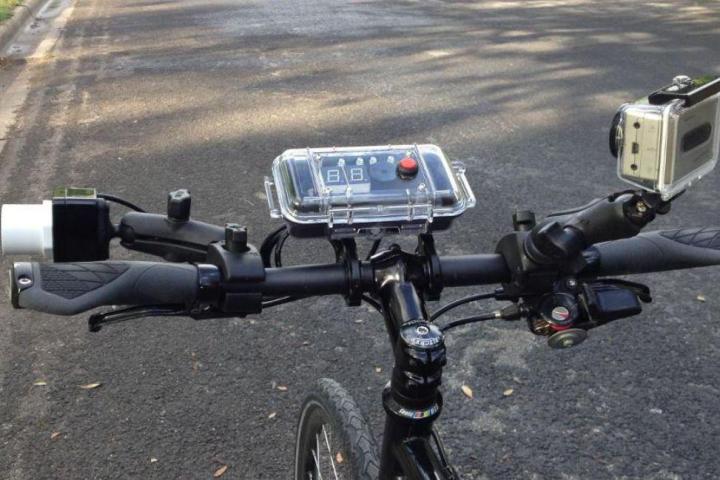
Up until now that has been a mere suggestion, since there’s been no real way to measure such offenses other than by eye. Codaxus LLC, an Austin-based startup has created an ultrasonic detector called Physics Package C3FT that mounts to bicycle handlebars expressly for the purpose of deducing passing distances. The detector itself sits on an adjustable arm and displays the distance measurement; sound and LEDs let the rider know when they’re too close.
There are different measurement modes; a continuous mode will show real-time distance measurements, while capture mode displays only the nearest measurement inside the set threshold, and the 3- and 6-foot Alarm mode triggers the buzzer and lights when someone buzzes the rider inside those thresholds. The setup can work in conjunction with a GoPro camera to record the display and the traffic.
The C3FT isn’t the kind of biking accessory the average person is likely to buy; it costs $1,400, which is more than the average bike you’re likely to see on the street. Codaxus points out that it’s likely to be of use to law enforcement, municipal planners, and researchers, but riders and drivers should know that it’s out there, ready to catch infractions. Citizen advocacy groups will likely want to use C3FT as well.
In fact, Friends of Outdoor Chattanooga, an outdoor activity advocacy group in Tennessee bought a device and donated it to the police department. The Chattanooga Police Department kicked off a Safe Bike Initiative in spring of 2015 in response to increased cycling in the area and the expected influx of even more cyclists for Ironman races in September and one that recently took place May 22.
The Safe Bike Initiative is being led by CPO Rob Simmons, who regularly takes the C3FT out for a spin. According to Simmons, drivers shouldn’t fear the mighty C3FT just yet. He said, “Our main goal is education.” He said most people know there’s some statute about passing, but not the specifics. He informs drivers and gives them a verbal warning. As with a lot of human interactions, attitude determines what actually happens — if they give him a hard time or don’t take the info he provides seriously, then he takes the next step and gives them a ticket. Breaking the city law will run a driver $120; ignoring the state law can cost a driver more than $200. By encouraging judges to order bicycle safety classes, Simmons shows he cares about affecting change rather than collecting fines.
Codaxus let Digital Trends know that another municipality near Tampa, Florida is the latest to grab a C3FT. New York, this writers home state, doesn’t have a legal definition of a “safe” distance but asks drivers overtaking from behind to pass to the left of bikes. New Jersey has no law protecting cyclists from being buzzed at all, but according to Christopher Stanton, co-founder of Codaxus, the times, they are a’changing: Ohio is another state that has no law protecting cyclists from being buzzed; the legislation was rejected as being impossible to enforce. Now that the C3FT exists it’s been added to the legislation, so it’s not only helpful to states that already have protective laws in place, but to those struggling to get statutes passed. Pennsylvania is the only state in the union with a 4 foot minimum passing distance, so be aware if you live in that state, commute through it, or are planning to visit.


